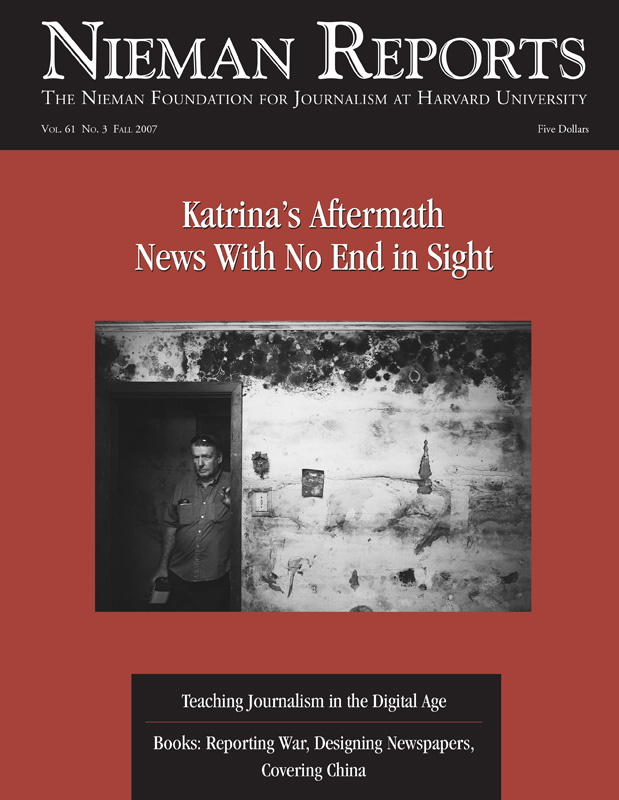Just as print and broadcast news media are reinventing themselves to fully embrace the Internet and newer media, schools and departments of journalism and communication are revamping their courses to acknowledge the Web’s growing dominance, powers of interactivity, and the convergence of print, broadcast and online environments. But how rapidly or radically the changes will happen are difficult, unanswered questions for the media and the universities.
In a short time since the emergence of the World Wide Web, the news media, especially newspapers, have significantly altered their attitude toward the Internet. After earlier bouts of arrogant skepticism, anger and denial, the traditional mass media now concede the seismic transformations of the newer media are irreversible. Google, with a market value of $144 billion from its Internet-based businesses, commands attention from a newspaper industry worth $55 billion in the United States and experiencing steady meltdown in circulation and advertising revenue.
Tom Curley, president and CEO of The Associated Press and a champion of online journalism, told me that while some in the newspaper industry still are “trapped in the ‘word world’ and need to go 10,000 feet higher into the multimedia world,” most have accepted the transition to online journalism. Internet users number more than one billion worldwide, and many eagerly participate in the interactive exchange as news-as-lecture gives way to the news-as-conversation. None of this is lost on the 458 universities and colleges in the United States and Puerto Rico from which 48,750 students AUTHOR’S NOTE
Becker’s 2005 survey also found that eight of 10 graduates believe people will get most of their news via the Internet in 20 years. Most of them already get most of their news from the Internet. The median salary of entry-level, Web-related journalism jobs was $32,000 entry salary compared with $28,000 for daily newspapers, $23,000 for TV, or $26,000 for radio.graduated in 2005 with bachelor’s degrees in journalism and mass communication (and 3,500 with master’s degrees), according to a survey by Professor Lee B. Becker at the University of Georgia.
Paradigmatic shifts in information exchange are causing universities to revise their course offerings, internships and applied research priorities. Though change can come slowly in the conservative, consensus-driven and budget-strapped halls of higher learning, it is under way. My experiences related to founding and directing a journalism department and journalism resources institute and then in helping design an interdisciplinary communication school at Rutgers, the State University of New Jersey, reminds me of challenges involved in keeping pace with rapid and significant technological changes.
Aligning Lessons With Newsroom Changes
Last year, I interviewed editors and publishers from all the daily newspapers serving New Jersey and many of the weekly community chains. My inquiries were made for a book I published in 2007, “From Ink on Paper to the Internet: Past Challenges and Future Transformations for New Jersey’s Newspapers,” when the New Jersey Press Association (NJPA) celebrated its 150th anniversary as the oldest continually operating press association in the nation. NJPA supported my research.
With these editors and publishers, I discussed two topics in particular:
- What they regard as the fate of newspapers 10 and 30 years from now and why.
- How universities can better educate future journalists or train existing newspaper staff.
The task faced by journalism and communication schools and departments in upgrading their curricula is akin to training pilots to fly experimental planes that are only partially operational for an aviation industry being totally transformed. Some are headed toward wholesale revision of their course offerings; others are choosing to retrofit their existing courses to accommodate the interactive, multimedia world. A go-slower, gradual revision approach might work best for some programs, or it might simply be dictated by the lack of a budget to do much more. But all agree that new course work is required so students have a comprehensive, hands-on experience working simultaneously in doing stories for print, broadcast and the Web. These skills—taught until recently as separate majors—must be converged in the curricula as they are now being used in newsrooms.
Such flattening of curricula is not easily done. Until now, faculty have been hired and promoted as specialists, while interdisciplinary experts—who are willing to teach—have been more difficult to recruit at a time when interactive multimedia news is still so new. Those who have this expertise command a higher salary. Graduate programs are preparing multimedia teachers, but this, too, requires resources and time. Universities also must be responsive to their students, many of whom remain focused on print or broadcasting and may resist being forced into a multimedia curriculum experiment. The fine line universities walk today is to be enough ahead of the change curve but not so far out in front that their graduates cannot perform in the print and broadcast environments where most jobs still reside.
Recognizing—and avoiding—short-lived media fads are other challenges. “Synergy” was seen as journalism’s path to a prosperous future just a few years ago, as media companies gobbled up competitors to create conglomerates of newspapers, magazines, television and radio, cable, satellite and online services. The belief was that once these media worked together in harmony—sharing content and consolidating newsroom resources—financial stability and journalistic success would materialize. Instead, the debris of such endeavors—with the travails of the Tribune Company and Time Warner—ought to be part of what students learn today. The dismantling of the revered Knight Ridder chain last year would serve to remind future journalists of how even an enlightened company investing in good journalism and newer media became a victim of stockholder feeding-frenzy.
Students should be taught to function in this age of convergence. “Repurposing” news and information might be an achievable strategy for future economic survival, but these students should be taught the necessary journalistic imperatives that go along with such use of material. And the dumping of news reporting into a super-processing vat and piping it out through multiple channels of print, broadcast and the Web can be seen as an easy task, but doing this becomes more meaningful work when it is done with an eye toward keeping journalism’s basic principles in mind.
Learning to work collegially in a wholly reorganized newsroom will be a skill that no student can afford not to acquire. Creating multimedia stories will require flexibility, a collaborative spirit, and strategic planning. These attributes are not now sufficiently emphasized in newsrooms or in classrooms. Yet these abilities must be part of what a potential journalist is able to offer an employer who now knows that success will depend on the Internet being fed stories told in multimedia ways. And some of the news and information to tell these stories will arrive from citizen journalists, Web forums, and Weblogs; finding ways to seamlessly integrate these various avenues of news will be essential, too.
To accomplish this, various approaches can be tried:
- Universities can test the possibilities and limits of convergence and multimedia journalism in controlled classroom news laboratory settings. [See author’s note.]
- Faculty can work closely with news organizations, which might be able to provide extra resources and equipment and monitoring.
- Internships can offer students a chance to participate in multimedia story-building in newsrooms.
- Journalism faculty doing applied research can measure what happens to their students in these classroom and professional settings through field visits and seminars.
- Universities must assess their faculty’s increased time pressures and the skills needed to teach effectively in this multimedia environment to prepare students for the realistic expectations of the workplace.
AUTHOR’S NOTE
These labs can offer students relevant exposure to the Internet, Web site building, experimentation with Weblogs, hands-on work with software packages for graphics and photos, and lots of time to report, write and edit for a range of platforms with text, graphics, sound, video and photos digitally mixed.Editors and publishers told me they want to hire journalists who have multimedia skills and experience. Young people already come to them attuned to the Internet, but some newspapers, such as Newark’s Star-Ledger, train every incoming journalist in computer-assisted reporting and database research. Increasingly, however, most papers will likely want journalists to have a firm foundation in these skills when they arrive.
Restructuring the Curricula
The key word that encompasses these changes in the classroom is “interdisciplinary.” Twenty-six years ago the provost at Rutgers asked me, as the head of the journalism department, to join the directors of communication and library sciences to design a new School of Communication, Information and Library Studies. Since then, information technology and several other centers focused on the media have been added. At that time, some thought this collaborative experiment would fail; as we attempted to do this, we endured critics who felt we were being unfaithful to our separate disciplines. Instead, this new school thrived, receiving many additional resources, and was positioned well when it came time to integrate new media advances. Since then, many schools have duplicated this multidisciplinary approach.
At European universities, there is much interest in this integrated approach, and Rutgers has shared its curriculum and training in many countries of Central and Eastern Europe. Presently, I am a program evaluator for a joint program of the journalism schools at the University of Missouri and Moscow State University in which its centerpiece has been funding of a new convergence news lab and curriculum, brought to Russian students by the talented Missouri faculty.
Media management courses should be used to help future journalists learn how to work with complex budgets, strategic planning, personnel issues, and decision-making about technology in this multimedia environment. Communication law courses can be used to help students become familiar with ethical, privacy, libel and copyright concerns that grow out of online delivery of news and information and media convergence. Other topics deserving careful academic attention include: audience and reader analysis; the behavioral impact of interactivity; social and educational policy; technological understanding of computers, the Internet and mobile devices, and the storage, retrieval of secondary use of information.
Journalism majors can be imbued with the excitement of gaining mastery of multimedia toolboxes. These will be tools they will use not only to get short-form news reports out quickly but also to develop longer, narrative accounts with links to documents to enhance credibility and the use of video, audio and graphics to place readers vividly at the scene. With these tools they will also be able to offer readers multiple perspectives on global stories as well as many dimensions of coverage of local news. And by knowing how to benefit from interactivity, these journalists will be able to tap into reader reactions, develop a network of new and valued sources, and gather reporting tips.
The editors and publishers I interviewed emphasized that universities should keep as their priority the core curriculum strengths of journalism education. These include teaching of solid research, interviewing, reporting, writing and editing skills; the broad knowledge of liberal arts and science studies; critical thinking and analysis, and high ethical standards and knowledge of press freedom and responsibility. Only when grounded in the fundamentals of journalism will this tree—from which many multimedia branches are now sprouting—be strengthened by the changes that are coming to our classrooms.
Jerome Aumente, a 1968 Nieman Fellow, is distinguished professor emeritus and special counselor to the dean in the School of Communication, Information and Library Studies at Rutgers, the State University of New Jersey.



